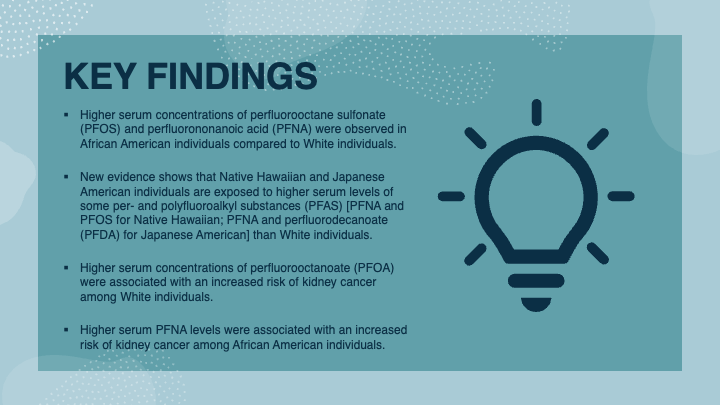
Every day we use various products without realizing how often we are exposed to chemicals. Our cooking pans and stain-resistant clothing can transfer harmful toxins to our food and body. Many of these chemicals are hazardous to human health and associated with cancer(1). In the United States, cancer is the second most common cause of death with an estimated 85% of cases thought to be driven by environmental and lifestyle factors(2).
As a Research Fellow in the Occupational and Environmental Epidemiology Branch at the Division of Cancer Epidemiology and Genetics at the National Cancer Institute, my research focuses on investigating the effects of environmental water and air pollutants on cancer risk. I am deeply committed to investigating this relationship within understudied racial and ethnic minority groups, including Asian American and Native Hawaiian and Pacific Islander (AA and NHPI) populations. My motivation stems from the limited data and understanding of environmental exposure profiles and their associated cancer risk within racial and ethnic minority communities. This knowledge gap hinders our ability to fully comprehend the true population patterns of environmental pollutants and associated health risks.
One of my primary research areas is the investigation of the relationship between exposures to per- and polyfluoroalkyl substances (PFAS) and cancer risk(3-8). PFAS are a group of environmentally persistent man-made chemicals, often known as “forever chemicals.” Since the 1940s, these chemicals have been commercially used in various products including nonstick cookware, food packaging, flame retardants, and stain-resistant fabrics(9). While there are over 12,000 identified PFAS, evidence regarding their toxicity and human health effects is available for only a small subset of widely used, long-chain PFAS chemicals, such as perfluorooctanoate (PFOA) and perfluorooctane sulfonate (PFOS)(10, 11). PFAS have been associated with a wide range of health effects, including altered antibody response and thyroid function, lipid and insulin dysregulation, kidney disease, and elevated risk of some cancers.(9, 12). Notably, in November 2023, the International Agency for Research on Cancer classified PFOA as a human carcinogen and PFOS as a possible human carcinogen(13).

PFAS are detectable in the serum of more than 95% of U.S. adults(14, 15). While the annual National Health and Nutrition Examination Survey (NHANES) provides information on biomarkers of environmental chemicals since 1999, information on racial and ethnic minority groups has been limited. NHANES only began providing biomarker data for non-Hispanic, Asian American individuals in 2011 with no data available for Native Hawaiian, Pacific Islander, American Indian, or Alaska Native individuals. Read more about how PFAS levels can influence cancer in my recent article.
Moving forward, my goal is to generate new data on known or suspected environmental carcinogens and related cancer risk in racial and ethnic minority groups with a particular focus on understudied AA and NHPI populations. I plan to identify the causes of exposure disparities in environmental carcinogens to help guide targeted environmental health interventions for populations experiencing the highest levels of environmental pollution, ultimately reducing health disparities.
Do you have a story idea for us? Do you want to submit a guest blog? If it's about equity, diversity, or inclusion, please submit to edi.stories@nih.gov.
For news, updates, and videos, subscribe or follow EDI on LinkedIn, X, Blog, and YouTube.
Sources
- World Health Organization. (2016) The public health impact of chemicals: knowns and unknowns.
- Anand P, Kunnumakkara AB, Sundaram C, et al. (2008) Cancer is a preventable disease that requires major lifestyle changes. Pharm Res. 25: 2097-116.
- Rhee J, Barry KH, Huang WY, et al. (2023) A prospective nested case-control study of serum concentrations of per- and polyfluoroalkyl substances and aggressive prostate cancer risk. Environ Res. 228: 115718.
- Purdue MP, Rhee J, Denic-Roberts H, et al. (2023) A Nested Case-Control Study of Serum Per- and Polyfluoroalkyl Substances and Testicular Germ Cell Tumors among U.S. Air Force Servicemen. Environ Health Perspect. 131: 77007.
- Chang VC, Rhee J, Berndt SI, et al. (2023) Serum perfluorooctane sulfonate and perfluorooctanoate and risk of postmenopausal breast cancer according to hormone receptor status: An analysis in the Prostate, Lung, Colorectal and Ovarian Cancer Screening Trial. Int J Cancer. 153: 775-82.
- Denic-Roberts H, McGlynn K, Rhee J, et al. (2023) Military occupation and testicular germ cell tumour risk among US Air Force servicemen. Occup Environ Med. 80: 312-8.
- Rhee J, Loftfield E, Albanes D, et al. (2023) A metabolomic investigation of serum perfluorooctane sulfonate and perfluorooctanoate. Environ Int. 180: 108198.
- Rhee J, Chang VC, Cheng I, et al. (2023) Serum concentrations of per- and polyfluoroalkyl substances and risk of renal cell carcinoma in the Multiethnic Cohort Study. Environ Int. 180: 108197.
- International Agency for Research on Cancer. (2016) Some Chemicals Used as Solvents and in Polymer Manufacture. IARC Monogr Eval Carcinog Risks Hum. 110: 37-110.
- Carlson LM, Angrish M, Shirke AV, et al. (2022) Systematic Evidence Map for Over One Hundred and Fifty Per- and Polyfluoroalkyl Substances (PFAS). Environ Health Perspect. 130: 56001.
- U.S. Environmental Protection Agency. Comptox Chemicals Dashboard: Master List of PFAS Substances (Version2).https://comptox.epa.gov/dashboard/chemical_lists/pfasmaster. Accessed Oct 2. 2022.
- Fenton SE, Ducatman A, Boobis A, et al. (2021) Per- and Polyfluoroalkyl Substance Toxicity and Human Health Review: Current State of Knowledge and Strategies for Informing Future Research. Environ Toxicol Chem. 40: 606-30.
- Zahm S, Bonde JP, Chiu WA, et al. (2024) Carcinogenicity of perfluorooctanoic acid and perfluorooctanesulfonic acid. Lancet Oncol. 25: 16-17.
- Calafat AM, Wong LY, Kuklenyik Z, Reidy JA, Needham LL. (2007) Polyfluoroalkyl chemicals in the U.S. population: Data from the National Health and Nutrition Examination Survey (NHANES) 2003-2004 and comparisons with NHANES 1999-2000. Environ Health Perspect. 115: 1596-602.
- Kato K, Wong LY, Jia LT, Kuklenyik Z, Calafat AM. (2011) Trends in exposure to polyfluoroalkyl chemicals in the U.S. Population: 1999-2008. Environ Sci Technol. 45: 8037-45






